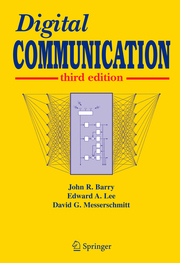Detailansicht
Digital Communication
2 Bde
ISBN/EAN: 9781461349754
Umbreit-Nr.: 5647124
Sprache:
Englisch
Umfang: xvii, 838 S.
Format in cm:
Einband:
kartoniertes Buch
Erschienen am 06.11.2012
Auflage: 3/2013
- Zusatztext
- This book concerns digital communication. Specifically, we treat the transport of bit streams from one geographical location to another over various physical media, such as wire pairs, coaxial cable, optical fiber, and radio. We also treat multiple-access channels, where there are potentially multiple transmitters and receivers sharing a common medium. Ten years have elapsed since the Second Edition, and there have been remarkable advances in wireless communication, including cellular telephony and wireless local-area networks. This Third Edition expands treatment of communication theories underlying wireless, and especially advanced techniques involving multiple antennas, which tum the traditional single-input single-output channel into a multiple-input multiple-output (MIMO) channel. This is more than a trivial advance, as it stimulates many advanced techniques such as adaptive antennas and coding techniques that take advantage of space as well as time. This is reflected in the addition of two new chapters, one on the theory of MIMO channels, and the other on diversity techniques for mitigating fading. The field of error-control coding has similarly undergone tremendous changes in the past decade, brought on by the invention of turbo codes in 1993 and the subsequent rediscovery of Gallager's low-density parity-check codes. Our treatment of error-control coding has been rewritten to reflect the current state of the art. Other materials have been reorganized and reworked, and three chapters from the previous edition have been moved to the book's Web site to make room.
- Kurztext
- This book is for designers and would-be designers of digital communication systems. The general approach of this book is to extract the common principles underlying a range of media and applications and present them in a unified framework. Digital Communication is relevant to the design of a variety of systems, including voice and video digital cellular telephone, digital CATV distribution, wireless LANs, digital subscriber loop, metallic Ethernet, voiceband data modems, and satellite communication systems. New in this Third Edition: New material on recent advances in wireless communications, error-control coding, and multi-user communications has been added. As a result, two new chapters have been added, one on the theory of MIMO channels, and the other on diversity techniques for mitigating fading. Errorcontrol coding has been rewritten to reflect the current state of the art. Chapters 6 through 9 from the Second Edition have been reorganized and streamlined to highlight pulse-amplitude modulation, becoming the new Chapters 5 through 7. Readability is increased by relegating many of the more detailed derivations to appendices and exercise solutions, both of which are included in the book. Exercises, problems, and solutions have been revised and expanded. Three chapters from the previous edition have been moved to the book's Web site to make room for new material. This book is ideal as a first-year graduate textbook, and is essential to many industry professionals. The book is attractive to both audiences through the inclusion of many practical examples and a practical flavor in the choice of topics. Digital Communication has a Web site at: http://www.ece.gatech.edu/~barry/digital/, where the reader may find additional information from the Second Edition, other supplementary materials, useful links, a problem solutions manual, and errata.
